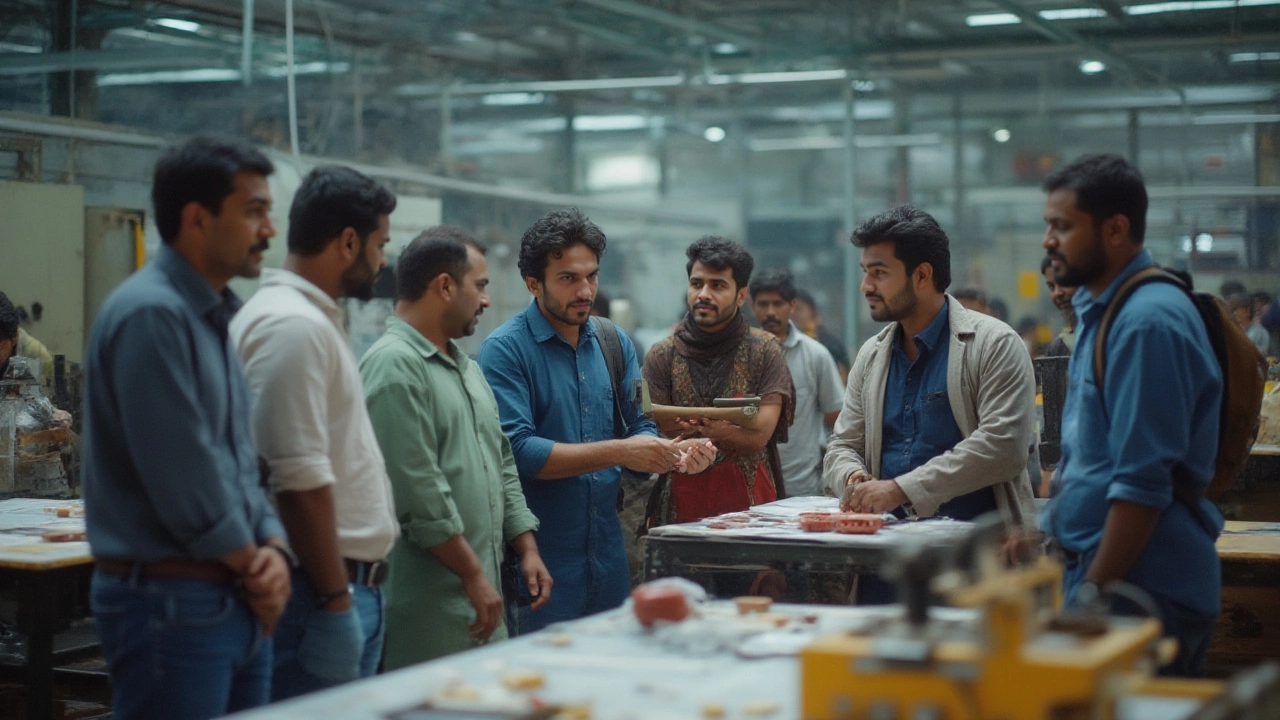Ever had an idea that just wouldn't leave your head? Maybe you pictured a gadget, a cool pet accessory (Rusty gets a vote for more comfy cat beds), or something to fix an everyday hassle. You can sketch on napkins, obsess over YouTube prototypes, but what turns an idea into something people can actually touch? Every big brand—think Dyson, LEGO, even those fidget spinners—started with someone looking at an everyday problem and saying, “I can make that better.” But jumping from inspiration to actual product is less about talent and more about rolling up your sleeves, making smart decisions, and outwitting all the curveballs along the way. The manufacturing world is wild, practical, and, honestly, kind of fun if you like building stuff and seeing it out in the real world. Here’s a practical, no-nonsense guide on how to start manufacturing a product—real talk, concrete advice, and hard-earned wisdom from folks who’ve been through it (and didn’t always get it right the first time).
From Cool Idea to Solid Product: Getting Your Concept Ready
It’s easy to think a product comes together in a flash. The hard truth? Solid products need more than inspiration. It usually starts out messy: sticky notes, doodles, late-night internet rabbit holes, feedback from friends who may or may not get it. Your main goal here is to make the idea so clear even a total stranger can picture it—and poke holes in it—before you obsess over manufacturing details.
You’ll need a detailed drawing or digital 3D model. Not a pro at design tools? Free software like Tinkercad or SketchUp is decent, but if you want something slick, find a freelancer or a friend who’s glued to CAD programs. Remember: the clearer the design, the fewer surprises down the road. Watch out for feature creep—adding too many bells and whistles is the quickest way to blow your budget before you even begin. Pick the problem you’re solving and strip the design to the essentials.
And testing? Oh, it’s not optional. Grab cardboard, LEGOs, duct tape—whatever lets you fake your idea in the real world. Want to make a better water bottle? Find out what leaks. Coffee mug? See how the handle feels with a drink inside. Early prototyping saves epic frustration later. Rusty, my cat, once shunned four different cat scratcher designs until I simplified it. (Lesson: pets are honest focus groups.)
Once you have a working sample, it’s time to find your first critics. Family and friends are nice, but get feedback from people who don’t owe you compliments. Ask them what’s confusing, what breaks, what doesn’t earn its spot on their shelf. Make changes, then test again. The more criticism now, the less disappointment once you’ve sunk cash into tooling and production runs.
Your next step: locking in your product specs. Write it up like you’re explaining it to a factory boss who’s never seen it—dimensions, materials, finish, color, weight, key features, even how it’s packaged. This document is your golden ticket to clear communication with manufacturers later. Get it messy now; tidy it only when you’re truly happy with the product’s look and feel.
The Real Cost of Manufacturing: Budgeting Beyond the Obvious
The best way to gut a great idea is to realize, halfway in, you can’t afford to finish it. Too many first-timers underestimate the hidden costs. Of course, there’s the price per product, but what about molds, samples, shipping, storage, quality checks, packaging tweaks, and that customs bill that arrives three weeks late?
Let’s get blunt: factories have minimum runs. For plastic products, the minimum order might be as high as 5,000 units. Each new design needs a unique mold; costs range from $1,000 for small parts to over $100,000 for big, complicated molds. Electronics? Add another pile of dollars for certifications and testing. Always ask for a clear price breakdown from the start. A lot of times, manufacturers can give you a sample quote table like this:
| Expense | Low Volume (<500 units) | High Volume (5,000+ units) |
|---|---|---|
| Mold Cost | $3,000 | $3,000 |
| Unit Price | $8.00 | $2.00 |
| Packaging | $1.50 | $0.75 |
| Shipping (per unit) | $2.00 | $1.00 |
Keep an emergency stash—experts recommend at least 20% over your best estimate—to cover mistakes, missed delivery dates, or a late-night brainstorm that means a last-minute design change. Also, don’t forget the costs to actually launch: branding, photos, website, copywriting, and maybe that irresistible unboxing video.
Next up, choose the type of manufacturing: local or overseas. Local factories can mean faster communication, quicker fixes, and easier visits, but often cost more. Overseas (China, Vietnam, Mexico, India) usually wins on price, but expect more language and timezone headaches, and sometimes longer sample delivery. Try looking for someone who offers hybrid solutions: final assembly local, parts from overseas.
How can you keep costs from spiraling? Negotiate everything, get all promises in writing, and be skeptical of the “too good to be true” quote. Ask manufacturers for references. Check if they’ve worked with your product type before—making t-shirts is not the same as building phone chargers.

Finding and Vetting the Right Manufacturer
You’ve nailed the concept, done the pricing math, now comes the ultimate scavenger hunt: the search for a manufacturing partner who can actually build your thing right. Start at the obvious: Alibaba, ThomasNet, Maker’s Row, and even LinkedIn groups. LinkedIn, by the way, can be gold for networking—many manufacturers post “guest posts” or updates about their facilities and work.
But don’t just fire off your specs and hope for the best. The trick? Approach this like dating: research, question, take it slow. Look for manufacturers who show off certifications (ISO 9001 is a good sign for quality). Ask about their recent clients—some will share photos of work or give a couple of names you can email. This is all about trust but verify.
Let’s talk about vetting. You want to see actual product photos from the floor, not just shiny marketing pics. Some factories will live-stream a walkaround or do WhatsApp video calls (seriously, that request is normal nowadays). Don’t be shy about grilling them on what could go wrong—if they can’t explain potential issues, keep looking.
Don’t rely on one quote. Get at least three, compare pricing, minimum orders, lead times, and payment terms. Watch for red flags—factories that ask for full payment upfront, can’t give exact sample timelines, or dodge questions. Also, factor in logistics: can they ship worldwide? Does their packaging meet your country’s safety rules? Different product categories (toys, electronics, food) have totally different safety and compliance requirements. Mess this up, and your launch can stall for months.
One often-overlooked move is getting a pre-production sample. Before spending big on a full run, ask for a small batch off the actual line, using final materials and exact packaging. Review this product like your grumpiest customer—including drop tests, heavy use, and temperature swings if it applies. Catching flaws here saves thousands later.
The Manufacturing Process: What Really Happens in the Factory
Pop quiz: once you place your order, do you just bite your nails until pallets arrive? Not if you want to save your sanity and cash. Even seasoned pro inventors will tell you the big messes sneak in during production, not before. Once you lock in your choice of manufacturer, here’s what typically goes down:
- Finalizing specs: Double and triple check the golden sample and written specifications. Everyone signs off before the machines roll.
- Ordering raw materials: The factory sources plastics, metals, cloth, or microchips—any hiccup or price spike here can delay everything.
- Molding or cutting: For plastics, the first test is “tooling”—producing the custom molds. Factories usually make a tiny batch first to check for defects.
- Assembly: Workers or robots assemble, stick on logos, and add finishing touches. Paint drying times and weather can even factor in for certain products.
- Quality control: Good manufacturers have random sample checks. Want to be certain? Hire a third-party to inspect the first major batch for issues. Amazon sellers call this a pre-shipment inspection—a small fee for a huge peace of mind.
- Packing and shipping: Every product gets boxed up as per your exact instructions (or mistakes get expensive). You’ll choose whether to pay for slow but affordable sea freight, or speedy (and pricier) air freight. Remember: the risk of damage in transit absolutely exists, so pay attention to packaging tests.
Production timelines depend hugely on what you’re making. Metal items get done faster than electronics (which need more tests). Holidays—like Chinese New Year—can freeze a factory for weeks, so always check the calendar and plan at least a few months ahead for any key deadlines.
The courier or freight company sits on a mountain of paperwork: customs documents, country-of-origin labels, insurance. One missing digit slows everything down. Consider hiring a freight forwarder early on—they eat this stuff for breakfast and can save you from surprise costs at the port.

Scaling Up and Growing Your Product Line
Pumping out the first hundred units? That’s tough but manageable. Scaling up to thousands? That’s where things get wild. Every successful maker or company hits growing pains: what works at small scale often cracks at higher volume. Suddenly, the glue takes too long to dry, the supplier runs out of your favorite color, or your quality checks miss a snag that turns social media ugly.
First growth tip: automate what you can. Ask the factory about options to add automation or semi-automation as volumes rise—maybe robots for packaging, or dedicated molds for unique versions. The up-front cost is higher, but the per-unit price usually drops nicely.
Keep your eye on supply chain headaches. Diversify suppliers where possible—just in case one shuts down or raises prices overnight. That might mean working with a sourcing agent, or keeping a running short-list of back-up suppliers for every major part or raw material. Some use digital dashboards to track raw material prices, spot delays early, and tweak production schedules as needed. Relying on one factory is like living with only one coffee mug; if it breaks, you’re stuck drinking from a bowl.
Your product itself should keep growing, too. Stay plugged in to customer feedback (and complaints), watch how people really use what you make, and tweak the next run accordingly. Sometimes, your very first customers are your biggest source of new ideas. Think about all the “second-gen” products out there—rarely did their first versions look like the polished best-sellers we see today.
It pays to invest a bit in branding and packaging. Even the smallest upgrade can massively change customer perception. Look up the data: according to a 2024 eCommerce report by Statista, 70% of buyers admit they’re swayed by packaging differences, especially in crowded markets.






